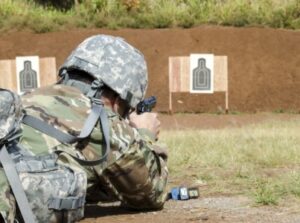
Daily use of naltrexone, a medication that blocks the effects of opioids with minimal side effects, doesn’t adversely affect the physical, cognitive or marksmanship performance of soldiers, according to a small study. Here, a fires an M9 pistol in 2019. U>S. Army photo
SILVER SPRING, MD — Daily use of naltrexone, a medication that blocks the effects of opioids with minimal side effects, doesn’t adversely affect the physical, cognitive or marksmanship performance of U.S. Army soldiers, according to a recent study.
The study published in Military Medicine evaluated the safety and tolerability of daily naltrexone use and its potential effects on the health and performance of healthy, nonsubstance-abusing military personnel. This topic hasn’t been widely studied, and it’s necessary to understand how prophylactic countermeasures affect military-relevant performance because of the potential of weaponized opioids, study authors suggested.1
The research team included investigators from the Walter Reed Army Institute of Research in Silver Spring, MD, and the U.S. Army Research Institute of Environmental Medicine in Natick, MA.
“The U.S. Army Research Institute of Environmental Medicine and the Walter Reed Army Institute of Research share a mission to provide research, engineering and analytical expertise to enhance Army capabilities now and in the future,” Maj. Jamie Carreno Davidson, PhD, primary investigator and deputy branch chief in the Walter Reed Army Institute of Research, Department of Military Psychiatry, told U.S. Medicine. “This study focused on delivering a capability commensurate with advances in modern technology that can bring new chemical threats to the U.S. servicemember.”
The study advised that “advancements in manufacturing of chemical weapons, including the use of aerosolized opioids, highlight the need to adequately prepare for this threat in military personnel.”
Participants in the study were 16 healthy male and female active-duty servicemembers, mostly young junior enlisted servicemembers (average age 23). The servicemembers, recruited from Advance Individual Training Units throughout the United States, agreed to live on the campus of the U.S. Army Research Institute of Environmental Medicine and participate in a series of studies focused on developing medical, environmental and performance solutions for the soldiers of the future, Davidson explained.
The soldiers were medically cleared to participate in the study based on normal findings during an initial physical examination, including vital signs and no self-reported history of cardiac problems, heart disease, heart attack or arrhythmia. They completed a series of physical, cognitive and marksmanship tasks during a 4-day pretrial, a 7-day active trial and a 4-day post-trial phase. During the active trial, participants were given 50 mg of oral naltrexone daily. “Physiological and biological processes were monitored with a daily review of systems, sleep monitoring, biochemistry and hematology blood panels,” the study reported.
“We found that daily naltrexone use in our small group of healthy active duty military soldiers did not affect the performance of their military tasks,” Davidson said. “This included physical, cognitive and marksmanship performance as well as sleeping patterns.”
“In this small, non-clinical study, temporary daily use of naltrexone was safe and did not negatively affect physical performance, cognitive functioning, marksmanship ability or sleep in our healthy cohort of U.S. Army soldiers. Considering the potential of weaponized opioids, this study was an important first step in evaluating how the use of prophylactic countermeasures impacts military-relevant performance,” Davidson added.
Physical Performance
For the study, physical performance was measured by the Army Combat Fitness Test (ACFT), the current physical fitness test for the Army. The ACFT was performed on days 4, 8 and 14 of the study. Cognitive performance was evaluated by the automated neuropsychological assessment metric (ANAM), which was administered on study days 4, 10 and 14. To gauge sleep, participants wore an actigraph (Actiwatch Spectrum Plus, Philips) during all study phases, and sleep duration and efficiency were calculated using the Actiwatch software package, according to a description of the study’s methods.
Marksmanship was measured by the Engagement Skills Trainer 2000, a small-arms simulated training system widely used throughout the U.S. Army, on days 2, 9 and 15 of the study. The system “provides visual, auditory and physical sensations that mimic those experienced when firing a military model M4 carbine rifle. The simulated weapon emits a laser at a screen about 30 feet away, and a computer determines and records shot accuracy based on where this laser is aimed at the time of trigger pull,” the authors explained.
This study was focused on the use of naltrexone in a healthy nonsubstance using sample with no history of substance abuse, so recommendations for healthcare professionals are related to use of the medication on a nonclinical sample. In a healthy nonclinical sample, “it may be important to monitor the use of legal substances such as alcohol given the unique pharmacological properties of naltrexone. This research restricted the use of alcohol while enrolled in the study and participants were screened daily for alcohol and substance use,” Davidson wrote in an email.
Limitations of the study include “the lack of a control or placebo group, which limits the ability to determine if observed cognitive improvements are the result of practice effects,” study authors pointed out. Because this study utilized a very small sample, it will be “important to replicate these findings in a larger sample with a broader representation of women as well as older adults who make up a considerable portion of our military service members,” Davidson added.
- Carreno-Davidson JT, Castellani CM, Carreno JJ, DeLuca JP, et. al. Daily Naltrexone Use Does Not Adversely Affect Physical, Cognitive or Marksmanship Performance in U.S. Army Soldiers. Mil Med. 2023 Aug 25:usad325. doi: 10.1093/milmed/usad325. Epub ahead of print. PMID: 37646761.

